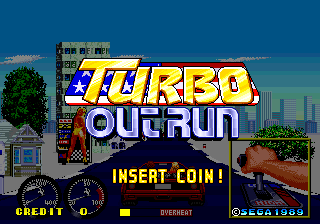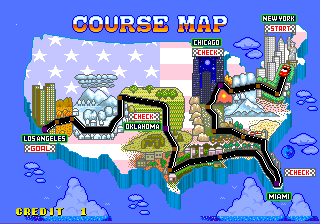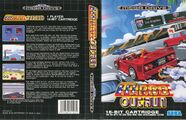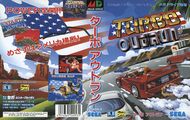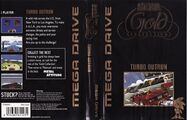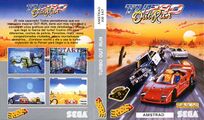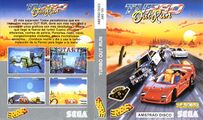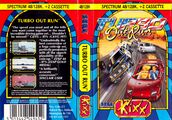Turbo OutRun
From Sega Retro
| Turbo OutRun | |||||
|---|---|---|---|---|---|
| System(s): Sega OutRun Hardware, Sega Mega Drive, Amiga, Amstrad CPC, Atari ST, Commodore 64, DOS, FM Towns, ZX Spectrum | |||||
| Publisher: Sega U.S. Gold | |||||
| Developer: Sega AM2 I.C.E. Probe Software Code to Go Tiertex (at least sound programming) | |||||
| Genre: Racing | |||||
|
Turbo OutRun (ターボアウトラン) is an arcade sequel to OutRun released in 1989. It was released as both a stand-alone arcade cabinet and as an upgrade kit to the original OutRun. Though not the first sequel to OutRun, Turbo OutRun is considered to be the first "true" sequel, having been built by a similar team at Sega AM2 with the arcades in mind.
Development
Though very different to the rest of the series, Turbo OutRun is arguably closer to Yu Suzuki's vision for the original OutRun, being set in the United States of America and featuring various scrapped ideas such as a checkpoint system.
Turbo OutRun wasn't as popular as the original game, but offered numerous graphical upgrades such as weather and road obstacles which would be included in other OutRun sequels to follow. Like its prequel, the player drives a car which looks suspeciously like Ferrari, however rather than being a Ferrari Testarossa, it is a Ferrari F40. Like OutRun Ferrari were not consulted during the development of this game.
Gameplay
Turbo OutRun has the player make a journey across the United States of America, from New York to Los Angeles. It is a more linear game than its predecessor, offering no forks in the road and therefore less of an incentive to play the game again after completion.
For the most part, the game is very similar to its predecessor, save for new graphics and music. Turbo OutRun offers several new features however, such as weather effects and obstacles which can slow your journey down. You are also set against a rival oppoenent, driving what appears to be a white Porsche 959 (a nod towards the rivalry between Ferrari and Porsche at that time).
The game is divided into four "sub-goals". Upon reaching a goal, the player is able to upgrade their car. If the oppoent gets to the goal first, the player's girlfriend will sit in the oppoent car in the next race, however if the player gets there first, a 1,000,000 point bonus is given.
The other major addition to Turbo OutRun is the inclusion of a "boost" button, which allows the car to travel faster. If the boost is left on for too long however, the car will overheat, and will be punished with slowdown. It is also the first OutRun game to offer an automatic transmission option.
The arcade version also allows you to continue from the beginning of the stage if you lose, a feature that did not survive into later OutRun games.
Re-releases
The game was ported to the Sega Mega Drive in 1992 exclusively in Japan and Europe, and was brought to the Amiga, Amstrad CPC, Atari ST, Commodore 64, DOS computers and ZX Spectrum too. Each of these ports suffer from cutbacks as sprite scaling is not supported by these systems.
Production Credits
Amiga Version
(C) 1989 Sega Enterprises Ltd
All Rights Reserved
Produced by I.C.E.
Programming by Martin Kane
Graphics by Freddy
Music by Uncle Art
Amstrad CPC Version
(C) 1989 Sega Enterprises Ltd
All Rights Reserved
Produced by ICE
Program: Alain Laird
With: John Bankier
Graphics: Freddy
Music: Uncle Art
Atari ST Version
(C) 1989 Sega Enterprises Ltd
All Rights Reserved
Produced by I.C.E.
Program by Ian Morrison
Graphics by Freddy
Music by Uncle Art
Commodore 64 Version
Copyright 1989 Sega Enterprises
Published by US Gold Ltd.
Conversion by Probe Software Ltd.
Programming and late nights by Mark (No memory left) Kelly
Presentation and introduction by Mark (On another planet) Hill
Grafix and excessive use of memory by Steve (You'll fit in) Crow
M-m-m-music by Maniacs of Noise
Hello to John Paul in Glasgow
DOS Version
© Sega Enterprises Ltd. 1990
Code to Go
Programmed by: D. Duncalf
Atr work by: D. Stubbington
Sound by: J. Brooke and Brian Rice
Physical Scans
Arcade Version
Template:ScanflyerTemplate:ScanflyerTemplate:Scanflyer
Mega Drive Version
| Sega Retro Average | |||||||||||||||||||||||||||||||||||||||||||||||||||||||||||||||||||||||||||||||||||||||||||||||||||||||||||||||||||||||||||||||||
|---|---|---|---|---|---|---|---|---|---|---|---|---|---|---|---|---|---|---|---|---|---|---|---|---|---|---|---|---|---|---|---|---|---|---|---|---|---|---|---|---|---|---|---|---|---|---|---|---|---|---|---|---|---|---|---|---|---|---|---|---|---|---|---|---|---|---|---|---|---|---|---|---|---|---|---|---|---|---|---|---|---|---|---|---|---|---|---|---|---|---|---|---|---|---|---|---|---|---|---|---|---|---|---|---|---|---|---|---|---|---|---|---|---|---|---|---|---|---|---|---|---|---|---|---|---|---|---|---|---|
|
| 57 | |
|---|---|
| Based on 25 reviews | |
| Mega Drive, AU (Sega Gold Collection) |
|---|
Amiga Version
| Sega Retro Average | ||||
|---|---|---|---|---|
|
| N/A | |
|---|---|
| Based on 0 reviews | |
Amstrad CPC Version
| Sega Retro Average | ||||
|---|---|---|---|---|
|
| N/A | |
|---|---|
| Based on 0 reviews | |
| Amstrad CPC, EU (Disk) |
|---|
|
Atari ST Version
| Sega Retro Average | ||||
|---|---|---|---|---|
|
| N/A | |
|---|---|
| Based on 0 reviews | |
| Atari ST, EU (Kixx) |
|---|
|
Commodore 64 Version
| Sega Retro Average | ||||
|---|---|---|---|---|
|
| N/A | |
|---|---|
| Based on 0 reviews | |
| Commodore 64, US |
|---|
|
| Commodore 64, EU (Kixx) |
|---|
|
DOS Version
| DOS, US |
|---|
|
FM Towns Version
ZX Spectrum Version
- ↑ Beep! MegaDrive, "April 1992" (JP; 1992-03-07), page 36
- ↑ Consoles +, "Février 1992" (FR; 1992-0x-xx), page 72
- ↑ Cool Gamer, "9" (RU; 2002-10-13), page 229
- ↑ Mean Machines: The Essential Sega Guide, "" (UK; 1993-11-18), page 111
- ↑ Hippon Super, "April 1992" (JP; 1992-03-04), page 84
- ↑ Hobby Consolas, "Julio 1992" (ES; 1992-0x-xx), page 90
- ↑ Joypad, "Juin 1992" (FR; 1992-05-1x), page 70
- ↑ Joystick, "Mai 1992" (FR; 1992-0x-xx), page 142
- ↑ Sega Mega Drive Advanced Gaming, "January 1993" (UK; 199x-xx-xx), page 95
- ↑ Mega Drive Fan, "June 1992" (JP; 1992-05-08), page 83
- ↑ Mega, "June 1993" (UK; 1993-05-20), page 21
- ↑ Mega, "June 1994" (UK; 1994-05-19), page 65
- ↑ Mega Force, "Juin 1992" (FR; 1992-06-05), page 78
- ↑ MegaTech, "April 1992" (UK; 1992-03-20), page 36
- ↑ Mean Machines, "March 1992" (UK; 1992-02-27), page 78
- ↑ Mean Machines Sega, "October 1992" (UK; 1992-09-xx), page 142
- ↑ Play Time, "7/92" (DE; 1992-06-03), page 91
- ↑ Sega Power, "May 1992" (UK; 1992-04-02), page 38
- ↑ Sega Pro, "May 1992" (UK; 1992-04-16), page 40
- ↑ Sega Pro, "April 1993" (UK; 1993-03-11), page 68
- ↑ Sega Opisaniy i sekretov, "14000 Opisaniy i sekretov" (RU; 2003-03-11), page 207
- ↑ Sega Saturn Magazine, "September 1995" (JP; 1995-08-08), page 87
- ↑ Supergame, "Junho 1992" (BR; 1992-06-xx), page 39
- ↑ Supersonic, "Juillet/Août 1992" (FR; 1992-xx-xx), page 12
- ↑ Video Games, "6/92" (DE; 1992-05-29), page 55
- No players field
- Use romtable template
- All games
- Old-style rating (joypad)
- Old-style rating (joystick)
- Rating without PDF source
- Old-style rating (mms)
- Update ratings template
- 3 old ratings
- Old-style rating (ace)
- 1 old ratings
- No ratings
- 2 old ratings
- Old-style rating (cvg)
- Old-style rating (yc)
- OutRun (franchise)
- OutRun Hardware Games
- Mega-Tech games
